The seagrass revival is both good news and a great sign of the progress we can make to create coastal environments that enhance biodiversity, support people and have the potential to slow climate change.
How it was
In 2021, Alix E. Green and Peter Jones, Peter J. S. Jones and Richard K. F. Unsworth published an analysis of how much seagrass used to exist around the UK, describing their findings as catastrophic.
Using “habitat suitability models” the team estimated that, since the earliest known records, seagrass losses around the UK coastline might be as high as 92%. At the mapped levels available in 2021, the analysis concluded that the 8,493 hectares (ha) of seagrass around the UK sequesters 0.9 million tonnes (Mt) of carbon. At the possible levels found around the coast over 100 years ago, the UK’s seagrass stored 11.5 Mt of carbon and supported 400 million fish.
“The first published account of seagrass in the United Kingdom that we are currently aware of was in 1831 (Winch, 1831), where it was included in a publication on the “Flora of Northumberland and Durham.” This observation is from a location on the Tyne River long since reclaimed and now an industrial estate.”
Searching for seagrass
Seagrass is found in intertidal and subtidal habitats. Intertidal is shoreline covered at high tide and uncovered at low tide, and subtidal coastline are areas always covered by water. Both of these seagrass-supporting shoreline habitats can be found from the Moray firth in Scotland to the Fal and Helford estuaries in Cornwall.
The historic-to-present mapping looked at many of these areas and today everyone can be part of the mapping and monitoring action to help protect and restore this valuable habitat. Environmental charity Project Seagrass has recently relaunched its SeagrassSpotter app, a smartphone-based tool to collect data on seagrass globally.
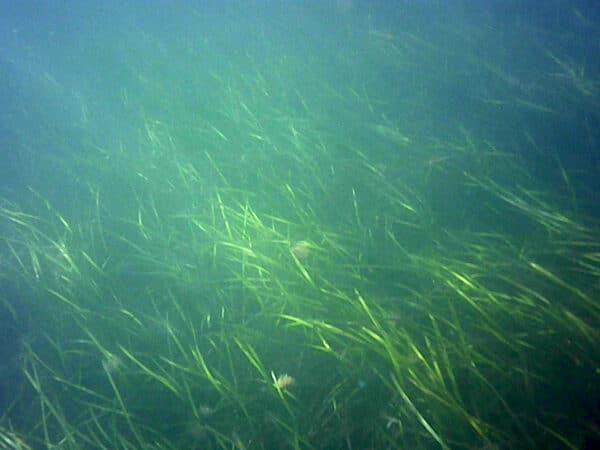
At the start of 2023, Stranger Collective made a donation to support Project Seagrass, part of our way of having a more positive environmental impact. After learning about the app, we took it out to the Helford River on a low spring tide afternoon. This is what we found.
Divers discovery
It’s around 2pm on a bright, sunny Saturday afternoon along the Helford Estuary. Goggles and wetsuit on, budget underwater camera in hand, I dive just below the surface into a mass of green.
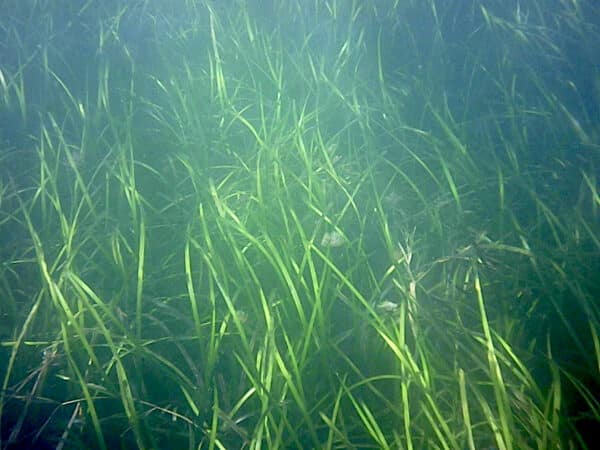
Diving through seagrass is magical. And I’d bet against anyone not agreeing with that after taking a dive. It is a vivid, rich underwater world, not instantly obvious from above. Within seconds of being among the seagrass strands I saw two fish swimming side by side, in between the thick vegetation.
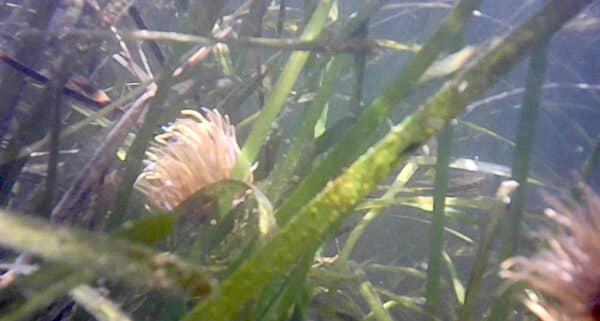
On a low spring tide, the density and extent of the seagrass growing here is easy to see, and spending just a few moments among it all, it’s clear that it’s a habitat full of life, for other species to be part of.
Seagrass spotted
The app provides identification guides and an easy interface to add an image of spotted seagrass, plus whatever information you can provide about the extent, appearance and human impact on that seagrass.
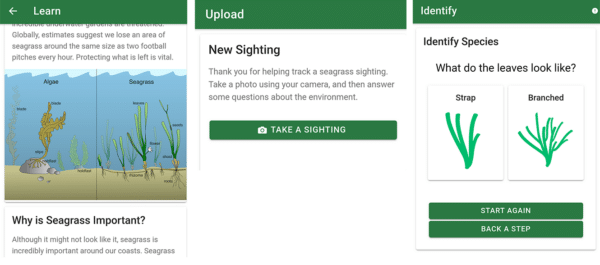
The latest version also allows avid seagrass spotters to report places where seagrass was but is no longer – absence sightings. Images and info can also be uploaded to the SeagrassSpotter website.
Preservation, restoration, sequestration
The Helford Estuary is a ria estuary – a drowned river valley formed by tectonic plate movements creating land subsidence or a rise in the sea level. Long ago, this created deep, well-defined marine environments. And prime seagrass conditions. It is abundant here in places along the estuary, but this could have been even greater once.
At most times the grass is totally submerged and only visible to divers. At a low spring tide it is a watery meadow you walk through. On a busy, sunny day at the beach it’s interesting to hear the different opinions swimmers and paddlers have about being among the marine plants. Some were fascinated, others wishing for clear plant-less water.
Climate and earth-system shifts created the conditions for seagrass to thrive epochs ago. In our post-industrial world we have the opportunity to re-create those conditions anew.
Awareness of what seagrass is, does, and could be, is on the up. The LIFE Recreation ReMEDIES project lead by Natural England in partnership with multiple organisations is planting seagrass, removing damaging moorings, exploring seagrass-safe alternatives for boats and publicising seagrass information.
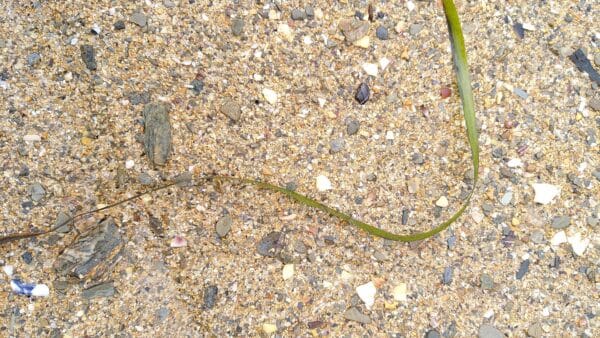
At Kiln Quay beach in Flushing, across the harbour from our Falmouth base, the sign greeting beachgoers reads: “The seabed off the beach is home to a vibrant seagrass bed full of marine life.” It also tells visitors that Falmouth Harbour have removed 11 swing moorings from the bay that were damaging the seagrass there. Just one of the many actions taking place to find, document, protect and restore the seagrass seabed.
Seagrass spotters can help all of those working to protect and regenerate seagrass monitor what is happening out in the wild.
Download the app, just enjoy the beauty of this ecological marvel next time you’re inter- or subtidal, or find out more about app creators and seagrass restorers Project Seagrass.
+